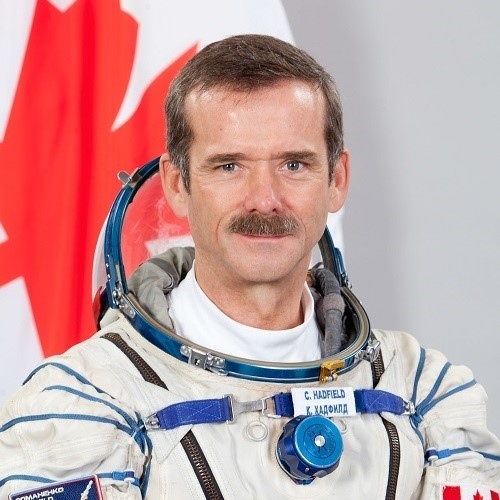by Neil Bowen for the Sarnia Observer
(2003) Astronaut Chris Hadfield maintains a vibrant Sarnia connection although he left the city as a young boy. The Observer has tracked his career for more than 15 years, including his time as a top fighter pilot from 1985 to 1988. He was photographed aboard his CF-18 at the Sarnia Airport. At the suggestion of an Observer reporter, it was later renamed the Sarnia Chris Hadfield Airport.
During his first space mission in 1995, The Observer sent a reporter to Cape Canaveral and Houston. It was one of the few times an Observer reporter has been sent outside southwestern Ontario. On every day of the mission, a package of articles was written with many making the front page. It was an interesting juggling of time as mission activities occurred during the night and early morning. At one point, a group of sleep-deprived reporters were staring into the night sky from the front lawn of Johnson Space Centre watching a streak of light that was the space shuttle. For its efforts, The Observer won a Thomson Canadian News Award honourable mention. When he flew into space again in 2001, the paper had two correspondents at Cape Canaveral to write stories and take pictures.
Since that first mission, Hadfield’s new assignments and promotions have been recorded by the newspaper. The major has become a colonel. He has served in Russia, and been the astronauts’ communications link with mission control. He has appeared in Sarnia numerous times and presented the city with momentos of his two missions. He has kept a continuing bond with the students of his elementary school in Sarnia, King George. Leaves from schoolyard trees have circled the earth.
Every time he appears, youngsters and even cynical adults are awed by his extraordinary abilities. He speaks three languages, English, French and Russian. He continues to be qualified as a jet pilot and he was the first Canadian to walk in space. His next assignment is being determined but he is committed to the space station project and wants to serve aboard it. While the station can accommodate a maximum of three people, maintenance and construction of components has required about 100,000 people backing them up on earth.
Whatever happens in the coming months, the space shuttle will remain a vital part of the space station project, according to Hadfield. His intelligence and physical skills could make space flight resemble a technical equation. But he’s never lost the boyhood fascination with space that started when he was watching the moon from the family cottage on Stag Island in the St. Clair River.


